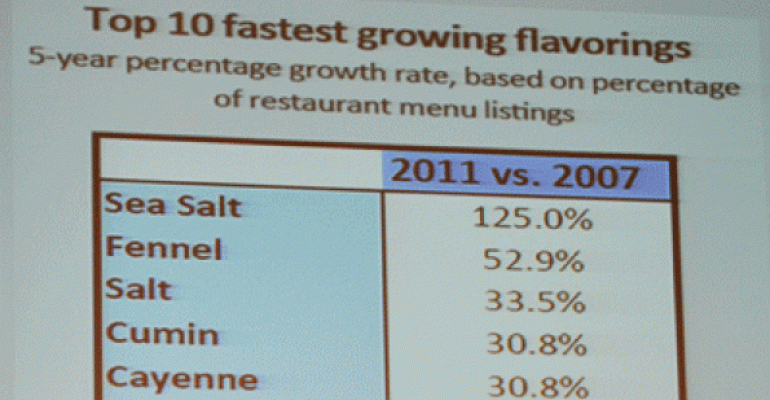Consumer demand for healthful foods, rising interest in local and sustainable products, and the continued popularity of food trucks were among the chief topics discussed at the 2012 annual Chain Operators Exchange, or COEX, this week, hosted by the International Foodservice Manufacturers Association.
Kevin Ryan, executive director of the International Corporate Chefs Association, presented Tuesday top menu trends during his “Culinary: Delighting Them” talk.
Ryan’s “2012 Trends to Watch” list included:
• Rising demand for healthful options
• Consumer push for minimally processed foods
• Consumer interest in supporting industry use of local and sustainable products
• Increased competition and “segment blurring,” as fine-dining chefs open casual or fast-casual restaurants. All industry segments continue to watch and emulate the fast-casual segment, which has captured consumers’ attention with its perceived mix of fresher, higher quality foods; more upscale ambience; affordability or better value proposition; and efficient service.
• Heightened grocery and convenience store competition
• Food trucks
• Growth in international markets.
Ryan also called 2012 “the year of the pig,” citing the proliferation of pork products in restaurants.
Food trucks keep rolling
While some industry observers had begun to dismiss food trucks as promotional ploys or training wheels for brick-and-mortar restaurants, Ryan noted their unique attributes.
• They are test kitchens on wheels that appeal to Millennials and can contribute to a “town square” feeling in some communities.
• They are known for their creative use of ingredients and newly fabricated cuts of meat, and offer artisan beverages.
• They can more easily create a farm connection because their relatively small product usage offers flexibility in product selection, and they can park near a farmers market or farm produce stand.
• They make creative use of new technology, such as global positioning tools and smart phone apps, to promote themselves and become integrated with their customers’ social media rituals. Their “elusive” nature, tied to changing routes and schedules and rotating menus, appeal to some consumers.
Food trucks are educating young people in cuisine and restaurants, said Heather Gardea, vice president of research and development for El Pollo Loco, in an operator discussion panel following Ryan’s presentation.
Eric Justice, vice president of culinary development for P.F. Chang’s China Bistro, who also was a part of that discussion, said Millennials are connecting with the authenticity and passion of some food trucks.
“Food trucks are accelerating all of these trends,” said Maeve Webster, director of research for Dataessential, after outlining the rise in popularity of different protein cuts or preparations, such as pork belly and air-dried salted beef, or bresaola.
In a “Deconstructing the Menu” workshop about center-of the-plate foods, Webster advised chain operators to track developments within food truck and independent restaurant circles, as they are sources of innovation.
“If you are only looking at your competitive [chain] set, you may be missing out on opportunities” to differentiate, she said, adding that watching independent operators can help chains differentiate.
COEX discussions also covered the following menu trends:
• The top 10 appetizer categories are salads, soups, breaded proteins, non-breaded proteins, dips, samplers, breaded vegetables, wings, quesadillas and nachos, according to Technomic.
• The greatest opportunity for growth in dessert sales, which have suffered since the recession, lies in increasing shareability, portability or an association with snacking, said Eric Giandelone, director of research for Mintel Foodservice.
The most ordered restaurant desserts by type and the percentage of surveyed consumers who said they ordered those foods were: cheesecake, 55 percent; sundae or ice cream, 50 percent; cake, 47 percent; milkshake or float, 39 percent; brownie, 39 percent; fruit pie, 39 percent; other pie, 34 percent; cobbler/crisp, 31 percent; cookie, 28 percent; bread pudding, 13 percent, Giandelone said.
Contact Alan J. Liddle at [email protected].
Follow him on Twitter: @AJ_NRN

